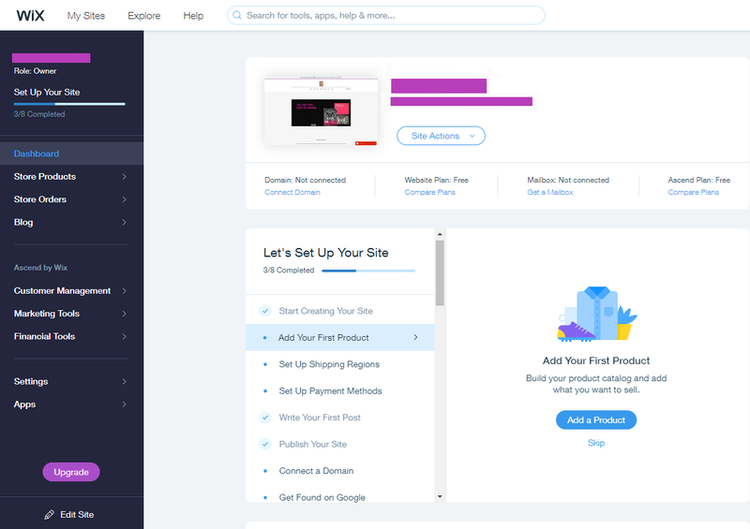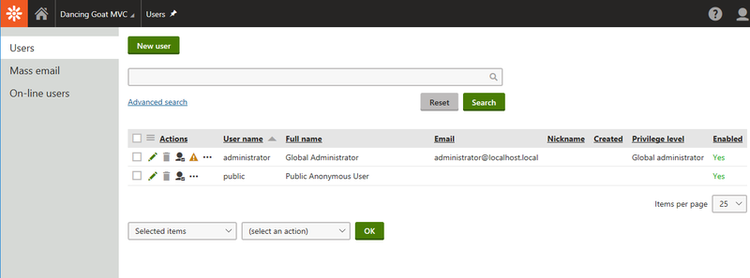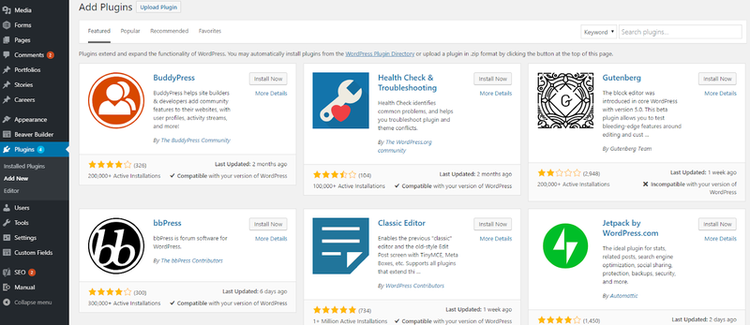A Guide to Effective Website Management
Many small business owners struggle with the question of how to manage a website. And it makes sense. You probably went into business to sell products, not to design websites and run them.
But the reality is, you won’t meet your marketing objectives without a website. Website marketing is critical to the success of just about every company in the 21st century, and it’s unlikely that you’re going to get away with not making it a central part of your small business marketing plan.
So if you’re struggling to get started with managing your own website, here’s an easy six-step process to help you get where you need to be.
6 steps to managing your small business’ website
Managing a small business website is a lot bigger undertaking than perhaps most owners realize. However, as long as you take the following six steps, you can increase the likelihood that your website will be a net positive.
Step 1: Determine available resources
It's one thing to say you're going to create and manage a website, but another to figure out who's going to be doing what. Managing a website is a lot of work, and you can't do it halfway if you want it to be a revenue generator for your business.
You'll need to come up with a plan that lays out who in your organization will be responsible for what, and how much time they should allocate to the project on a weekly basis.
Best practices for determining available resources:
Figuring out the available resources may actually be the most difficult part of the entire process, because you’ll need to figure out who needs to be taken off of other projects to tackle this new project. There’s a way to do it methodically, however.
- Identify the stakeholders: Come up with a list of everyone who should be involved in the website, such as a writer or a video editor or an IT person.
- Assign them roles: Create a list of roles for the website and assign each of these individuals to those roles, with clearly defined responsibilities attached to them.
- Give them hours: If you’re not careful, the website can sap all of the attention of their team. If you’d rather they not spend all their time on the website, give them a set number of hours to work on it, and then revisit to come up with another solution if it’s not getting the job done.
Step 2: Choose a content management system
A content management system (CMS) can help you both design a website, manage all of the basic functions, and create a strategy that can help you produce a content plan that will increase your efficiency. CMS software is good for simplifying website management services, which requires some programming skills if you want to do it on your own.
A good CMS platform is in the eye of the beholder, however, so try a few options out first. You’ll find you gravitate to some platforms more than others because they just fit your work style more.
Best practices for choosing a content management system:
Good content management is all about simplifying the whole website creation and management process, and there are a couple of additional things you should keep in mind when choosing one.
- Don’t forget security: Make sure whatever website management system you have has good security features, like a firewall and encryption. Create some best practices for your own business, like longer, more complex passwords and training to help employees spot phishing attempts, for example.
- Make sure it has good support: Sometimes, it’s better to have imperfect software and great support than the opposite. Seek out software options that offer one-on-one support from the developer so that you can troubleshoot problems and potentially adapt the software to fit your organization better.
Step 3: Create content
Content refers to anything you put on your website that a visitor might consume. Blog posts are a common form of content, but you may also find you connect with your audience through videos, downloadables, or even live events like webinars. Content is vital if you want your website to generate leads, and it’s a great way to get free traffic.
You will need to put together a thoughtful content strategy that understands what your customer wants from you and delivers that on a regular basis. For example, if your customers want to know how to keep security threats from causing problems for their small business, you might write articles or produce videos for tips on dealing with security risks.
Best practices for creating content:
A lot of people just throw content at the wall to see what sticks, but that’s not an effective strategy. You have to come up with a plan, and there are a couple things you should keep in mind when doing so.
- Be mindful of SEO: It’s best to identify keywords that your customers are searching for and create articles that target those terms. You can use tools like Google Keyword Planner or Ahrefs to identify them.
- Above all else, be helpful: Search engine algorithms have gotten very sophisticated in recent years, so drafting low-quality content stuffed with keywords just doesn’t work anymore. On the plus side, that simplifies things: just create solid, helpful content for your readers that uses keywords in a commonsense way, and you will be rewarded.
Step 4: Seek help
It’s a great idea to seek out other people to produce content on your website. If you use expert guest posters, it’s free and saves you a lot of work, and it increases the reputation of your own site by having a respected individual in your field share their knowledge on your site.
You need to start developing relationships that you can leverage into guest writing opportunities, both for yourself on their website and for them on your website. For example, if you offer affordable IT security solutions to small businesses, then you could partner with an IT security expert and author to produce a series of educational webinars.
Best practices for seeking help:
Developing mutually beneficial relationships in the business world can be a tricky prospect, but it’s absolutely worth putting the time and effort to create them.
- Make a list: Chances are, you probably have a few individuals or businesses in mind who could help you get your business to the next level, so write them down in one place.
- Develop a strategy for each: For some, all it may take is a phone call to ask about a partnership possibility. Others you might want to go a longer route and just start with a quick introduction over coffee.
- Be genuine: Relationships work best when you are authentic with each other, so don’t be fake just to score a blog post.
Step 5: Monitor traffic
As traffic moves in and out of your site, visitors are producing extremely important data, and you’d better be capturing these marketing analytics or you are missing out on key opportunities to increase efficiency and ultimately boost revenues. Sites like Google Analytics and Clicky are great for keeping track of important metrics like bounce rate, time on page, and so on.
With this data in hand, you can answer critical questions that directly affect your bottom line, such as:
- Why are such a huge volume of visitors leaving as soon as they hit my landing page?
- What are my most popular pieces of content so I know what to produce in the future?
- How many visitors does it take for me to make one sale?
Best practices for monitoring traffic:
Gathering data should be pretty straightforward if you have the right tools, but there are a couple of pitfalls when it comes to monitoring traffic that you should be on the watch for.
- Don't jump to conclusions: You shouldn't throw out your entire landing page because the bounce rate is high. Maybe you just need to move a couple of things around. Data needs context, so don't take any one data point as a sign that you need to make radical changes.
- Track the right metrics: Some metrics matter more to businesses than others. Perhaps time on page isn't important for your kind of business, but it could be everything to another. Be selective about which metrics you track.
Step 6: Make adjustments
In the digital age, the name of the game in the business world is adaptability. You must be able to adjust on the fly. With plenty of data in hand, you should be able to come to conclusions about how to position your business in a way that will lead to growth down the line.
It’s good to set up a regular time to review the data and brainstorm some adjustments to your business. Quarterly is generally a good time to take stock of how you’ve performed and examine how you could be doing better. But you may opt to go with a monthly, or even weekly schedule -- just avoid overdoing it, because it’s hard to come up with enough data over a short period of time to make any hard and fast conclusions. You do want some stability as a business.
Best practices for making adjustments:
Change is hard, but it can also be quite beneficial to your bottom line.
- Be at peace with change: Any business that operates in the 21st century, regardless of the industry, must become accustomed to change. You need to structure your business so that you can adjust quickly when new data comes in.
- Keep an eye on your competitors: If you notice your competitors have taken a drastic new approach, maybe it’s time to take a deep dive into your own data to see if you are missing something.
The best content management system for managing your business website
So, what content management system is right for your business? That is highly dependent on how you operate on a day-to-day basis, but we’ve chosen the following three software options as among the best we’ve seen.
1. Wix
The beauty of Wix is its simplicity. It’s like a canvas on which any individual, regardless of tech experience, can start designing an attractive and professional-looking website within minutes of signing up for an account. You’ll have lots of templates to choose from, but you can do plenty of customization if you would rather go that route.

Wix’s dashboard is easy to navigate. Image source: Author
2. Kentico
Kentico is a better fit for larger enterprise operations that have to handle a lot of traffic or want websites with multiple functions. It's a pricier option that might not be right for small businesses who need something simple, but you can't do much better when it comes to sheer website management power.

Kentico makes it easier to manage a team of contributors. Image source: Author
3. WordPress
WordPress has been the gold standard for content management for a very long time, and it’s still widely used today. It has a pretty straightforward blogging and publishing function, plus a lot of plug-ins and extra features if you want to try some of the more advanced website management tools.

WordPress offers a variety of extra plug-ins and advanced features. Image source: Author
Website management doesn’t need to be a chore
Creating an effective website doesn’t have to take all of your time and resources. If you can identify what objectives you’re trying to meet and map out a plan to get there, it can become an important marketing tool in your business without taking over your life. It can also serve as an outlet to share your expertise with the world in a way that will also get people excited to try your products or services.
Don’t forget there are lots of software tools to help you out. Whether you're looking for the best blogging platform or just want to be better at webpage management, there are a ton of solutions out there that can make running a website enjoyable rather than a chore. So try a few CMS software options and see if they work for your business.
Alert: our top-rated cash back card now has 0% intro APR until 2025
This credit card is not just good – it’s so exceptional that our experts use it personally. It features a lengthy 0% intro APR period, a cash back rate of up to 5%, and all somehow for no annual fee! Click here to read our full review for free and apply in just 2 minutes.
Our Research Expert
We're firm believers in the Golden Rule, which is why editorial opinions are ours alone and have not been previously reviewed, approved, or endorsed by included advertisers. The Ascent does not cover all offers on the market. Editorial content from The Ascent is separate from The Motley Fool editorial content and is created by a different analyst team.
Related Articles
View All Articles